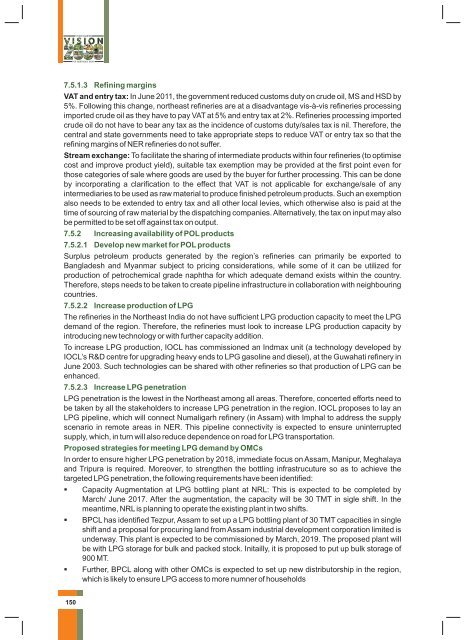Hydrocarbon Vision 2030 (ஹைட்ரோகார்பன் தொலைநோக்கு ஆவணம் 2030)
Create successful ePaper yourself
Turn your PDF publications into a flip-book with our unique Google optimized e-Paper software.
7.5.1.3 Refining margins<br />
VAT and entry tax: In June 2011, the government reduced customs duty on crude oil, MS and HSD by<br />
5%. Following this change, northeast refineries are at a disadvantage vis-à-vis refineries processing<br />
imported crude oil as they have to pay VAT at 5% and entry tax at 2%. Refineries processing imported<br />
crude oil do not have to bear any tax as the incidence of customs duty/sales tax is nil. Therefore, the<br />
central and state governments need to take appropriate steps to reduce VAT or entry tax so that the<br />
refining margins of NER refineries do not suffer.<br />
Stream exchange: To facilitate the sharing of intermediate products within four refineries (to optimise<br />
cost and improve product yield), suitable tax exemption may be provided at the first point even for<br />
those categories of sale where goods are used by the buyer for further processing. This can be done<br />
by incorporating a clarification to the effect that VAT is not applicable for exchange/sale of any<br />
intermediaries to be used as raw material to produce finished petroleum products. Such an exemption<br />
also needs to be extended to entry tax and all other local levies, which otherwise also is paid at the<br />
time of sourcing of raw material by the dispatching companies. Alternatively, the tax on input may also<br />
be permitted to be set off against tax on output.<br />
7.5.2 Increasing availability of POL products<br />
7.5.2.1 Develop new market for POL products<br />
Surplus petroleum products generated by the region’s refineries can primarily be exported to<br />
Bangladesh and Myanmar subject to pricing considerations, while some of it can be utilized for<br />
production of petrochemical grade naphtha for which adequate demand exists within the country.<br />
Therefore, steps needs to be taken to create pipeline infrastructure in collaboration with neighbouring<br />
countries.<br />
7.5.2.2 Increase production of LPG<br />
The refineries in the Northeast India do not have sufficient LPG production capacity to meet the LPG<br />
demand of the region. Therefore, the refineries must look to increase LPG production capacity by<br />
introducing new technology or with further capacity addition.<br />
To increase LPG production, IOCL has commissioned an Indmax unit (a technology developed by<br />
IOCL’s R&D centre for upgrading heavy ends to LPG gasoline and diesel), at the Guwahati refinery in<br />
June 2003. Such technologies can be shared with other refineries so that production of LPG can be<br />
enhanced.<br />
7.5.2.3 Increase LPG penetration<br />
LPG penetration is the lowest in the Northeast among all areas. Therefore, concerted efforts need to<br />
be taken by all the stakeholders to increase LPG penetration in the region. IOCL proposes to lay an<br />
LPG pipeline, which will connect Numaligarh refinery (in Assam) with Imphal to address the supply<br />
scenario in remote areas in NER. This pipeline connectivity is expected to ensure uninterrupted<br />
supply, which, in turn will also reduce dependence on road for LPG transportation.<br />
Proposed strategies for meeting LPG demand by OMCs<br />
In order to ensure higher LPG penetration by 2018, immediate focus on Assam, Manipur, Meghalaya<br />
and Tripura is required. Moreover, to strengthen the bottling infrastrucuture so as to achieve the<br />
targeted LPG penetration, the following requirements have been identified:<br />
Capacity Augmentation at LPG bottling plant at NRL: This is expected to be completed by<br />
March/ June 2017. After the augmentation, the capacity will be 30 TMT in sigle shift. In the<br />
meantime, NRL is planning to operate the existing plant in two shifts.<br />
BPCL has identified Tezpur, Assam to set up a LPG bottling plant of 30 TMT capacities in single<br />
shift and a proposal for procuring land from Assam industrial development corporation limited is<br />
underway. This plant is expected to be commissioned by March, 2019. The proposed plant will<br />
be with LPG storage for bulk and packed stock. Initailly, it is proposed to put up bulk storage of<br />
900 MT.<br />
Further, BPCL along with other OMCs is expected to set up new distributorship in the region,<br />
which is likely to ensure LPG access to more numner of households<br />
150

















